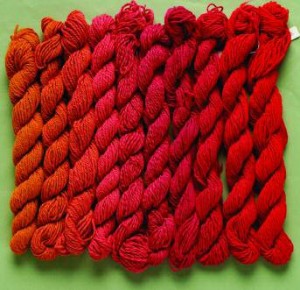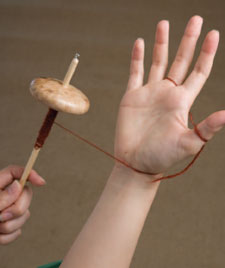
You've mastered spinning a singles yarn and now it is time to ply yarn. The concept is simple enough—just take two (or three, or four, or more) singles, hold them together, and ply them by twisting them in the opposite direction they were originally spun. Simple, but the possibilities are endless—how do you keep them from getting tangled? How much twist do you insert? How many plies do you include? What about novelty yarns? What if you're using different fibers or colors in each ply? This is why plying is an art—you get to choose the composition of your yarn and each of these decisions, whether made consciously or unconsciously, will determine the outcome of your yarn and eventually the outcome of your finished piece.
If that sounds daunting, don't worry—you've got the likes of Maggie Casey, Judith MacKenzie, Rita Buchanan and other spinning masters within the pages of our free How to Ply Yarn eBook, titled "How to Ply Yarn: From Plying on a Drop Spindle to Creating Plied Yarn on a Wheel", to guide you through the process. We've pulled together a handful of useful and inspiring plying articles from the past thirty-five years of Spin-Off so that this information is in one handy place. We know that this free eBook contains a wealth of information for the beginning spinner, but I know from my own experiences that when I take a moment to review material that I think I comprehend, I always learn something new—greater depth is revealed each time I take the time to look at something again with fresh eyes.
A plied yarn is stronger, more consistent, and more stable than the singles from which it is made. Also, in the ply structure, more of the individual fibers are covered and protected from abrasive wear, light and chemical damage. Whether you're learning for the first time, want to weigh the benefits of single- vs. multiple-ply yarn, or want tips for plying on a drop spindle, this eBook is packed with helpful tips for spinners of all skill levels.
A Closer Look by Rita Buchanan

Plying is optional—using unplied or singles yarn—saves precious time. Efficiency and productivity were urgent concerns when everything was made from handspun fiber, which explains why, traditionally, most handspun textiles were made from singles. Yet some traditional textiles were made from two-ply yarns, and now we usually ply. Learn about psychological motives, practical benefits, and design opportunities of the craft.
Self-Ply by Carol Huebscher Rhoades

Have you been perplexed in a spinning class when the teacher recommends letting the singles "self-ply" or "ply back on itself" to test the yarn size? It's a simple technique that one often sees in classes but isn't usually described in spinning books. All you do is take some yarn from the bobbin, hold the yarn taut, fold it in half, and release the folded end held by the back hand so that the yarn twists together. Usually the self-plied yarn has less ply twist than separate singles plied on the wheel or spindle, but this quick method will give you a basic idea of what the finished yarn will look like.
Plying on a Spindle by Maggie Casey

This method is easy! In fact, there are many ways to do it: Andean plying, multiple spindles, center-pull ball, and more. Maggie has tried them all and she prefers to transfer the singles from her spindle to a storage device (such as a felt ball) before plying. She wraps the yarn around small felt balls and puts each ball in its own upside-down clay flowerpots threading the yarn through the hole in the bottom to manage the yarn while she plies—a trick she learned from Rita Buchanan. Included in this article is tips on how to ply using a flowerpot, lazy kate, and spindle.
The Art of Ply by Judith MacKenzie

As many spinning teachers will tell you, this method covers a multitude of sins—at least of the textile kind! It does this in a number of ways: it makes the finished yarn more consistent, much stronger, and certainly more stable. The consistency comes from averaging out the diameters of the singles as they are plied together. When we ply, thin and thick places will often merge together, and when they don't, there are good plying tricks to help this happen. Of course, the more singles used to make a plied yarn, the more opportunities available to make an even yarn. It also takes only a third of the time it takes to spin the original singles and plied yarn will make much more fabric than the singles will.
Plying Chained Singles by Dodie Rush

Commonly known among spinners as "Navajo-plying", plying chained singles produces a three-ply yarn from a bobbin of singles yarn and is accomplished by "chaining" loops; each new loop is drawn through the previous loop. With this technique, you can create the appearance and stability of three-ply yarn from one bobbin of singles instead of three. You may be familiar with chaining a warp for weaving, creating a crochet chain, or making a chain stitch in embroidery, but you can't make a stable yarn just chaining a strand of spun singles. The chained singles need sufficient twist in the opposite direction to balance the twist of the singles.
Andean Plying by Rudy Amann

For spinners using handspindles, the Andean plying method is an easy way to ply the yarn from a spindle. It is also a great way to ply small samples—a spinner's equivalent to a knitter's swatch. Rudy spins a singles for about twenty minutes and then uses the Andean hand wrap to prepare the yarn for plying.
Happy spinning,
Amy

